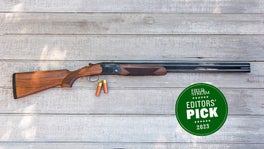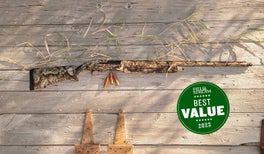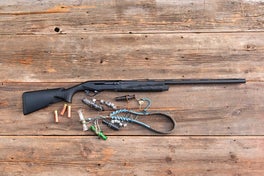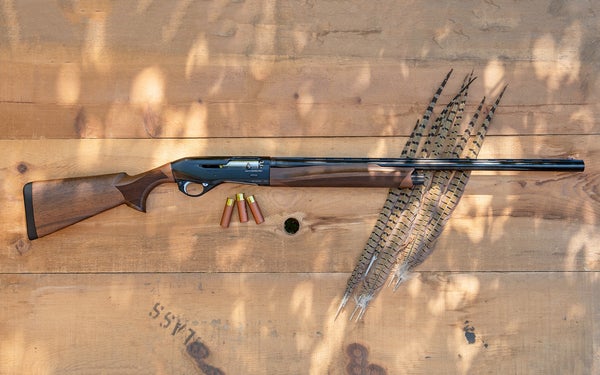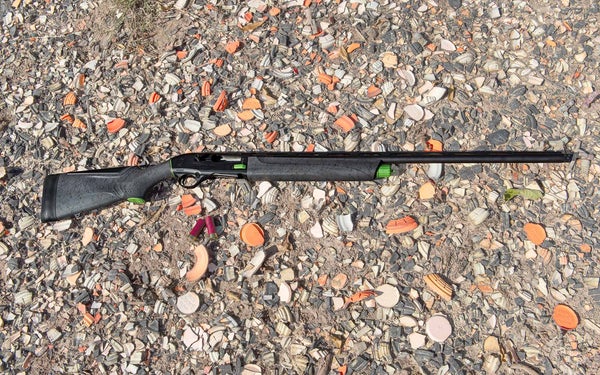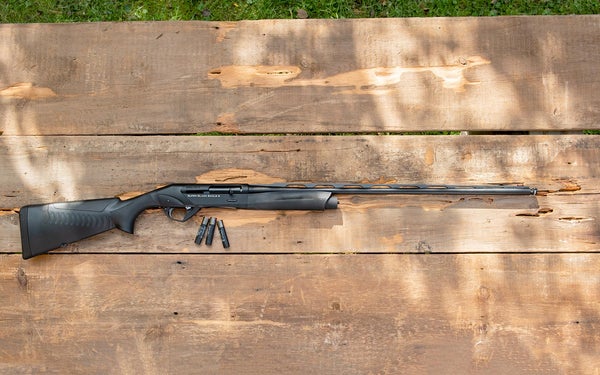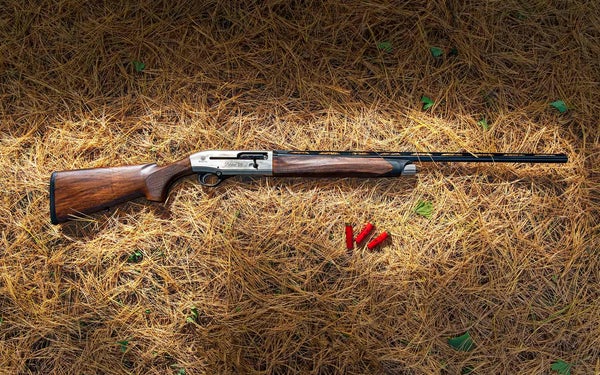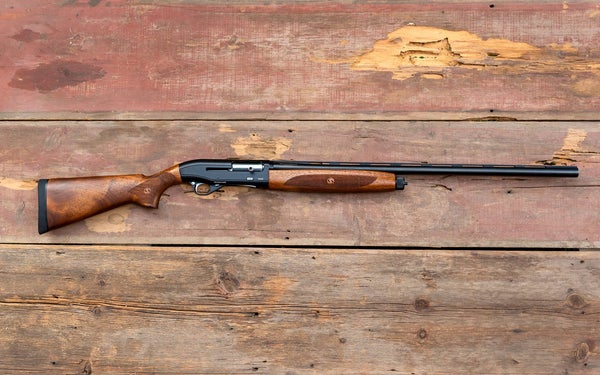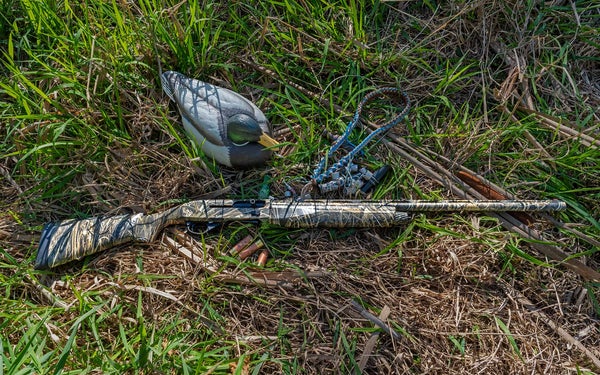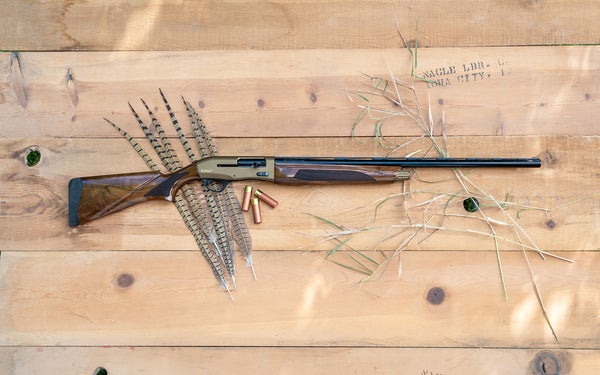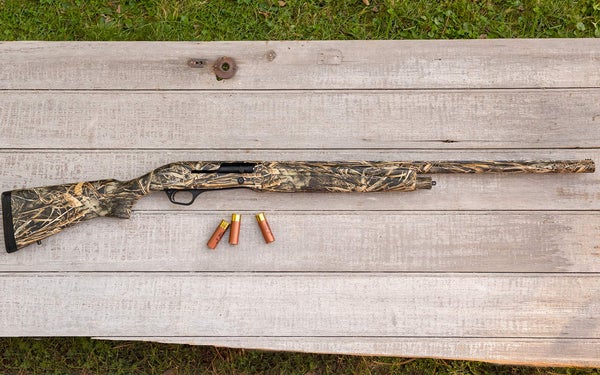We may earn revenue from the products available on this page and participate in affiliate programs. Learn more ›
Contrary to popular belief, you can have enough shotguns, assuming you choose the right ones. The problem—or the opportunity if you prefer to look at it that way (and we do)—lies in the fact that the right one might have just recently hit the market. Even as I try to trim my own modest accumulation of shotguns, manufacturers keep making new models I want. There’s no shortage of keepers in the guns manufacturers recently sent me to evaluate for our Best Shotguns of 2023 test and review.
This year’s crop of new shotguns offers an interesting mix of styles and innovations. There really is something for everyone, from target shooters and turkey hunters to upland hunters to waterfowlers. (Check out our list of the best duck hunting shotguns.) And I had to examples of this year’s “it” gun—the 3-inch 28-gauge—to evaluate. Through the good part of a week, I put a total of 14 new shotguns through the wringer in order to pick the best shotguns of 2023. Here they are.
The Best Shotguns of 2023
- Editor’s Pick: Beretta Ultraleggero
- Best Target Gun: Fabarm Elos D2 RS
- Best Value: CZ 712 G3
- Best Makeover Gun: Benelli M2
- Best Comeback: Remington 870 Synthetic
- Best Turkey Gun: Mossberg 500 20-gauge Optic Ready
The Rest of the Best Shotguns of 2023
- Benelli Montefeltro
- Beretta A300 Ultima Sporting
- Benelli 28-gauge SBE3 BE S.T.
- Beretta A400 28 gauge
- Stevens 560
- Stoeger M3000
- Tristar Viper G2 PRO
- Tristar Matrix
How We Test for the Best Shotguns


I gave the guns a workout at skeet and 5-stand. I tested with light target loads for reliability and heavy hunting loads to see how hard they kicked. I shot them for point of impact and patterned the lone turkey gun. When I needed a second opinion, I called in Clint Hartsock, fellow clay and wingshooter and hunting department manager at Fin and Feather in Iowa City. His perspective as both a shotgunner and a retailer, provided useful insights.
After thoroughly testing all of the shotguns, and keeping notes along the way, I ultimately scored each on a 100-point scale, based on the following categories and point values:
Workmanship and Aesthetics: Fit and finish inside and out matter, both for function and for appearance. (Worth up to 20 points)
Reliability: A shotgun has to be reliable. Since there’s only so much I can learn without spending a whole season with a gun, this category only counts for up to 10 points.
Handling and Recoil: Shotguns are instinctively dynamic. How they carry, point, swing, and kick matters as much or more than anything else. (20 points)
Ergonomics: Controls that are hard to find or stiff can cost you chances in the field, and they can make shooting a less pleasant experience. (10 points)
Meets Intended Purpose: Some guns are all-purpose, some are specialized. Whatever the case, a shotgun that doesn’t do what you need it to do isn’t worth owning. (10 points)
Innovation: It’s hard to come up with truly new ideas in shotgun design. This category celebrates real innovation, while recognizing that innovation is rare. (10 points)
Value: It’s your money. You want to spend it, not waste it. Getting a sound return for your dollars is important. (20 points)
The Best Shotguns of 2023: Test Results and Reviews
Editor’s Pick: Beretta Ultraleggero
Why it Made the Cut: A novel approach solves the old question of how to lighten a gun without ruining its balance.
Total Score: 94
Key Features
- Length: 45 ½ inches
- Weight: 6 pounds, 6 ounces
- Barrels: 28 inches
- Action: break-action O/U
- Trigger: 5 pounds, 6 ounces
- Finish: Blue, with 3-D engraved inserts
- Stock: Oil-finished walnut
- Chambering: 2 ¾- and 3-inch 12-gauge
- Price: $3,000
Pros
- Lightweight
- Excellent balance
- Innovative use of lighweight materials
- Good looking, in a different way
Cons
- Kicks with heavier 12-gauge loads
Beretta’s design team replaced wood with plastic in an upland O/U and made me like it. That level of innovation and execution makes the Ultraleggero (Italian for “Ultralight”) the winner of this year’s test. At 6 pounds, 6 ounces, it’s a gun you can carry all day, while still receiving the benefits of the 12’s unmatched versatility. You can load it down to 20- or even 28-gauge levels for woodcock, and power it up for long-range shots at wild ringnecks.

Shaving ounces from a 12-gauge by using lighter materials isn’t a new idea. There are plenty of alloy-frame O/Us on the market. The Ultraleggero is different. It starts with the steel-framed Beretta 690 action. The receiver is skeletonized, saving ounces while maintaining rigidity. Plastic inserts fill the empty spaces. Weight savings don’t stop there. The barrels have no mid-rib, and the forend iron is split into two pieces, with the latch being plastic. The stock has been aggressively hollowed out, and the end result is a gun that has lost weight all over, so it retains good balance.
And, it’s surprisingly pleasing to look at despite the use of non-traditional materials in a traditional design. At least I think so. Scroll designs decorate the bottom and side 3-D printed inserts in a way that shifts depending on the light. Beretta plans to offer other the option of having custom inserts printed from customer images so you can commemorate, say, a favorite dog.
I hunted with an Ultraleggero for half of last pheasant season and loved the way it carried and handled for me. It is true that once I got above 1 1/8-ounce loads I could definitely feel the gun go off. If I bought one, I’d add a Kick-Eez or similar pad. That’s the end of the Ultraleggero’s shortcomings, however, and it is my favorite new gun of the year.
Best Target Gun: Fabarm Elos D2 RS
Why it Made the Cut: It’s a great shooter and a lot of target gun for the money
Total Score: 92
Key Features
- Length: 45 ½ inches
- Weight: 8 pounds, 5 ounces
- Barrels: 32 inches, target-style tapered rib, four extended choke tube (30-inch also available)
- Action: Break-action O/U
- Trigger: 3 ¾ pounds
- Finish: Semi-matte blue, enamel accents
- Stock: Oil-finished walnut
- Chambering: 2 ¾- and 3-inch 12-gauge
- Price: $3,575
Pros
- Excellent choice for shooters who like a smoother, steadier gun
- Good trigger pulls
- Adjustable hardware works well
- Good value
Cons
- Light blue/white enamel accents, black comb, and Euro-styling may not appeal to everyone
There were only two target guns entered this year. More entries would only have meant more guns finishing behind the Elos N2 RS. Its combination of features, the comparative value it offers, and the fact that I loved shooting it, meant that as long as I was chief judge it was going to be the winning target gun, and it came close to being the winning gun overall.
Fabarm made guns long before it became part of the Caesar Guerini. Fabarm is serious about barrel-making and goes the extra mile by making their own choke tubes. In terms of its action design, a Farbarm O/U is very similar to a Guerini. Contemporary, European styling, and much lower prices distinguish Fabarms from Guerinis.

Fabarm already had a sporter, the Elos N2. Starting with that platform, Fabarm added ¾ of a pound of weight. A solid mid-rib hidden beneath the forend adds ounces between the shooter’s hands. A beefier stock and rounded-tip forend contribute to the weight gain as well, making the gun feels smooth and disciplined, but not at all muzzle heavy. My test gun weighed 8 pounds, 5 ounces. That extra weight steadies gun and absorbs recoil. I found it a total joy to shoot. Everything works, the adjustable comb hardware is durable. The triggers break light and clean.
A well-executed oil finish enhances the handsome walnut furniture. The black comb, enamel highlights and overall styling might be acquired taste, but it’s easily acquired, especially after you have a chance to break targets with this gun. And, although $3,500 is far from cheap, the gun compares favorably to other clay-breakers that cost much more.
Best Value: CZ 712 G3
Why it Made the Cut: Old-school gas gun tech helps CZ bring this gun in at a price that’s hard to beat.
Total Score: 72
Key Features
- Length: 48 ½ inches
- Weight: 7 pounds, 7 ounces
- Barrels: 24 inches (black only), 26, and 28
- Action: Gas
- Trigger: 6 pounds
- Finish: Camo (tested), black synthetic, walnut/blue also available
- Stock: Synthetic
- Barrel: White Bradley bead, five extended chokes
- Chambering: 3-inch 12-gauge
- Price: $579, walnut and blued steel black, $619, walnut/blued or camo; $669, Cerakote metal, camo furniture
Pros
- Enlarged controls
- Stock shims
- Weight forward balance
- Soft recoil
- Sturdy hard case
Cons
- Barrel retaining nut means an extra step is required to assemble and disassemble for cleaning or switching pistons
CZ’s gas gun is now in its third iteration. This version comes with a new receiver profile, stock shims, a bigger bolt handle and release, plus an enlarged safety and a bolt-lock button that, unlike almost all other bolt locks, is easy to find and press. I liked the gun’s 7 ½-pound heft, which made it an easy gun to shoot. Combined with a soft pad and gas operation, that weight helped the 712 win as the softest-shooting among the 12-gauge semiauto field guns I tried when I ran high-velocity duck loads through it. (That doesn’t include the Beretta A300, which is a clays gun.) With the light load piston in place, the gun cycled 7/8-ounce, 1200 fps target loads with no problem.

The 712 G3 comes with five extended chokes and shims. You also get a very sturdy hard case for it. It works, shoots softly, and points well. Switching pistons requires an extra step, if you want so switch from, say, 3-inch goose loads for a morning hunt to light dove loads in the afternoon. Also, there’s a barrel ring nut that has to go over two sets of threads every time you want to remove or replace the barrel to change pistons or take the gun down for cleaning or storage. It’s a pain, but while you are spinning this nut on and off the mag tube, you can reflect on what a great deal you go on this soft-shooting shotgun.
Best Makeover: Benelli M2
Why it Made the Cut: Smart ergonomic improvements and no more “inertia clicks” make this new M2 the best M2.
Total Score: 86
Key Features
- Length: 49 inches with 28-inch barrel
- Weight: 6 pounds, 15 ounces
- Barrels: 24, 26 and 28 (tested) inches, stepped rib, fiber-optic bead
- Action: Inertia semiauto
- Trigger: 5 pounds, 4 ounces
- Finish: Matte blue
- Stock: Black synthetic, standard and compact lengths
- Chambering: 3-inch 12-gauge, 3-inch 20-gauge
- Price: $1,399 black, $1,499 camo
Pros
- Shoots flat
- Well thought-out ergonomic improvements
- Easy-Locking bolt increases reliablity
Cons:
- New styling < old styling, but I am already over it
Several of the guns in the test were made-over versions of their previous selves: the Stoeger 3000, the TriStar Viper G2, the CZ 712 G3, the Benelli M2, and Montefeltro. The M2 was my favorite. It is the fashion these days to add a big bolt handle and a “slammer button” bolt closer and call your gun “improved.” Benelli went a step further with its makeovers. They restyled the guns and modestly enlarged the bolt handle and button to the point where they are ergonomically useful but never in the way. The bolt handles are bigger, but won’t gouge the gun next to them in the cabinet. The bolt release is easy to push, but hard to bump accidentally. Thumbing shells into the magazine, which can become a chore with Benellis and frozen fingers, is now much easier thanks to a softer magazine tube spring and a redesigned shell latch.

Finally, the gun has the Easy-Locking bolt. For years, the Achille’s Heel of otherwise ultra-reliable inertia guns was the ease with which the bolt could be bumped out of battery, causing a misfire. Benelli fixed the problem with the Easy Locking bolt, which first appeared on the Ethos and SBE3. This year, you can get it on the M2 and Montefeltro, and this is cause for celebration.
The M2 comes only in synthetic stocked version. Mine shot dead on, not high like some previous Benellis. It cycled loads as light as 7/8-ounce, 1200 fps, out of the box and functioned perfectly. It was a pleasure to shoot and would make a great all-around hunting gun. While I preferred the lines of the old M2, this one has enough improvements that its looks are starting to grow on me.
Best Comeback: Remington 870 Synthetic
Why it Made the Cut: America’s workhorse works again.
Total Score: 84
Key Features
- Length: 48 1/2 inches (12-gauge with 28-inch barrel)
- Weight: 7.5 pounds in 12 gauge with 28-inch barrel
- Barrels: 21 (20-gauge only), 26 or 28 inches
- Action: Slide action
- Trigger: 5 pounds
- Finish: Matte blue
- Stock: Black
- Chambering: 12-gauge 3-inch, 20-gauge 3-inch
- Price: $600
Pros
- Smooth function
- Soft comb piece and pad reduce felt recoil
- Improved metal finish
Cons
- 20-gauge version lacks comb pad
- Lots of take-up in the trigger
In the year 2000, when Remington 870 celebrated its 50th birthday, the word “iconic” still meant something, and the 870 was a genuine icon. A triumph of mass production, the 870 stood for reliability anyone could afford, and for American industrial know-how. Everybody owned an 870 because you could depend on it.
Cost-cutting measures and mismanagement in the 21st century turned America’s pump from classic to clunker. New owners RemArms took over a couple of years ago, introducing first a wood-stocked “FieldMaster” that was an upgrade over the last Remington 870 Express guns (albeit at a higher price) in every way. This year they came out with a synthetic FieldMaster that I like even better than the wood version.

It has a clean look, good lines, and it adds an effective soft comb insert that combines with its Super Cell recoil pad to make it a very comfortable to pump gun to shoot. In addition, the synthetic stock has some very grippy checkering molded into it that will make the gun easier to hang onto in any weather.
Yes, it costs $100 more than an Express did, but the metal finish is more rust resistant than the old, worthless bead-blasted finish. Redesigned action bars smooth the gun’s stroke, and the forend extends back to the receiver for those of us who like to choke up on the gun. A drilled and tapped receiver, three included choke tubes, and a white bead in a drilled, tapped hole in place of the old staked-in metal bead all make this gun several cuts above the last 870s straggling out of the Remington factory before the new owners took over.
The trigger breaks at five pounds with a lot of pre-travel. It didn’t bother me at all when I shot clays, but if I were using this gun for turkeys I might seek out a gunsmith or a Timney 870 Trigger Fix kit. Otherwise I could find nothing to dislike about this gun.
Best Turkey Gun: Mossberg 500 20-Gauge Optic Ready
Why it Made the Cut: The optic cut in the 500 receiver puts the red dot right where you need it on top of an old favorite.
Total Score: 71
Key Features
- Length: 42.75 inches
- Weight: 6.5 pounds
- Barrels: 22 inches
- Action: Pump action
- Trigger: 7.5 pounds
- Finish: Mossy Oak Green Leaf
- Stock: Synthetic
- Chambering: 20 gauge, .410
- Price: $644
Pros
- Factory choke patterns well
- Removable plate and drilled and tapped receiver offer numerous optic options
Cons
- Heavy trigger
- Fiber optics flimsy
Having missed my share, and possibly also your share, too, of turkeys in the era before red dots, I am a red-dot believer now. Mossberg was the first gunmaker to think of putting an optic-cut on a shotgun receiver. A removable plate lets you mount an RMSc Shield-footprint sight low so you don’t have to lift your head off the stock to use it. The optic cut first appeared on the 940 gas gun last year, but since turkeys and pumps go together, putting the same cut on a Model 500 is a stroke of genius.

My test gun is a typical Model 500, with all that is good and bad about it. The good: It’s smooth. It’s affordable. It will always work. It sports a cool retro Green Leaf finish. The bad: The plastic safety is stiff. The fiber-optic bead is flimsy. The trigger is heavy. I have never liked the attached barrel nut of the Model 500.
A $25 aftermarket tactical safety solves the safety problem. You don’t need the bead if you have a red dot, and there’s definitely no need to spend the money on a new turkey choke. At 40 yards, the factory choke put 144 pellets out of a 277 pellet Hevi18 load of 7 shot in into a 10-inch circle. With Federal’s 1 5/8 7×9 blends it made 220 hits on target. The 500 comes in a 20-gauge and a .410.
Benelli Montefeltro
Why it Made the Cut: The Montefeltro benefits from the same ergo-improvements lavished upon the M2, with similarly good results.
Total Score: 83
Key Features
- Length: 48 1/2 inches (12-gauge with 28-inch barrel)
- Weight: 6 pounds, 12 ounces in 12 gauge with 28-inch barrel
- Barrels: 24, 26 and 28 inches
- Action: Inertia semiauto
- Trigger: 5 pounds
- Finish: Gloss blue
- Stock: Satin-finished walnut, standard and compact models available
- Chambering: 12-gauge 3-inch, 20-gauge 3-inch
- Price: $1,499
Pros
- Ease of loading
- Click-proof bolt
- Light weight
- Handles well
Cons
- Loses something in the restyling, but it’s still better than ever
Like the M2, the Montefeltro receives a makeover this year and, ergonomically, the results are just as good. Loading is much easier, the bolt can’t be bumped out of battery and the controls are easy to use. At 6 ¾ pounds it’s the weight of a good 16-gauge or an overweight 20. It’s the ideal upland semiauto and no slouch as a duck gun, either. The test gun worked perfectly, and I had a chance to shoot ducks, geese, and pheasants with it last fall, all to good effect.

I preferred the old lines of the Montefeltro, and while I have gotten used to most of the restyling, the aggressively curved pistol grip still bugs me. But, that’s just me. The only thing that is objectively worse is the cheap-feeling magazine cap on this new version. Everything else about the styling is a matter of personal preference.
Beretta A300 Ultima Sporting
Why it Made the Cut: Beretta deservedly dominates the sporting semi-auto category, and the A300 has championship bloodlines. It’s not good looking, but you’ll look awfully good wearing the medal it wins for you.
Total Score: 79
Key Features
- Length: 51 inches
- Weight: 7 pounds, 12 ounces
- Barrels: 30 inches
- Action: Gas semiauto
- Trigger: 5 pounds, 12 ounces
- Finish: Matte blue, lime green highlights
- Stock: Gray synthetic, black accents
- Chambering: 2 ¾- and 3-inch 12-gauge
- Price: $1,100
Pros
- Outstanding, proven design
- Very soft recoil
- Good value
Cons
- It’s cosmetically challenged
- Some fit and finish wrinkles to iron out
“Beauty is only skin deep, ugly goes to the bone,” is a saying both older than you think it is (it dates at least to the 1840s) and as often wrong as it is correct. Take Beretta’s A300 Ultima Sporting. It hides a ton of inner beauty beneath a façade that, while it may appeal to some, is objectively ugly. First, the good part: It’s an A300, a slightly modified version of the great Beretta 391, one of the best gas guns ever. It has all of the A300’s reliability. It also features a variation of the Kick-Off recoil reducer found on other Berettas. The gun’s 7 ¾-pound weight, the reducer, and gas operation all combine to dramatically cut the kick of even heavy target loads. Low recoil, plus the gun’s length, heft and balance made it an easy gun to break targets with.

Cosmetically, the gun is challenged. The gray synthetic stock has black paint dripped on it, Jackson Pollack-style, and the grip cap, spacer, bolt closer and magazine cap are all bright lime green. Those accent parts, I understand, will be changeable so they can be matched to team colors. It’s a neat idea, if not that well executed. The lime green plastic cover on the bolt-close button interfered with its proper function half the time. For some mysterious reason the receiver has six holes bored in the top, all filled with plastic plugs, one of which fell out during shooting. There was a bit of bubbling in the black finish on the receiver. I would assume these cosmetic errors will be corrected soon, and none of them prevented the gun from crushing targets with little effort and less recoil. It also has a 3-inch chamber and sling swivel studs so it could go to the dove field or duck blind.
Benelli 28-Gauge SBE3 BE S.T.
Why it Made the Cut: The Super Black Eagle 3 is not what you’d call cute . . . until you see one in 28-gauge.
Total Score: 75
Key Features
- Length: 48 1/2 inches
- Gauge: 3-inch 28 gauge
- Weight: 5.5 pounds
- Barrels: 26 or 28 inches
- Action: Inertia semiauto
- Trigger: 6 pounds, 6 ounces
- Finish: Black, with BE S.T. scratch and corrosion-resistant coating
- Stock: Black
- Chambering: 3-inch 28-gauge
- Price: $2,099 with BE S.T., $1899, black, $1999, camo
Pros
- All the features of an SBE 3 in a 5 ½ pound package
- BE S.T. means this gun will never rust
- Shoots reliably
Cons
- Extremely muzzle-light
This wisp of a gun has all the features of the bigger SBEs: ergonomically designed controls, ease of loading, a recoil reducing stock, the Easy-Locking bolt and, as you’d expect, extra-trim lines. Our test gun featured the weather-proof, scratch resistant BE S.T. coating as well. Stoked with ammo like 1-ounce loads of HeviXII, the 3-inch 28 shoots some dangerous patterns. The smallest SBE 3 is a genuine waterfowl gun.
At 5.5 pounds, it’s a wonderful gun to carry, but the weight-saving carbon fiber rib removes weight where the gun needs it most. The 28-gauge SBE3 is extremely muzzle-light, and therefore a great gun for carrying one-handed in a thicket, pointing and shooting at ducks over decoys or shooting at flushing upland birds going straight away. But, that muzzle-light balance gives you no help at all when you’re swinging at longer crossing targets, as I found shooting clays and hunting doves with it.
Beretta A400 28 Gauge
Why it Made the Cut: Beretta semiauto reliability and soft recoil in a lightweight, 3-inch 28-gauge gun is enough to get anyone’s attention.
Total Score: 74
Key Features
- Length: 48.5 with 28-inch barrel
- Weight: 5.8 pounds
- Barrels: 28 inches
- Action: gas semiauto
- Trigger: 5 pounds 6 ounces
- Finish: Silver anodized receiver, blued steel
- Stock: Walnut with enhanced grain
- Chambering: 3-inch 28-gauge
- Price: $1829
Pros
- Reliable
- Soft-shooting
- Good balance for a light gun
Cons
- “Enhanced” wood grain and silver mag cap won’t appeal to everyone’s taste
Beretta’s latest addition to the A400 line is the “Upland 28 Magnum,” chambered for the trendy new 3-inch 28-gauge. Like the 12- and 20-gauge A400s, this gun runs with famous reliability, kicks softly and cycles very fast due to its rotary bolt design. It does lack the Kick-Off recoil reduction system found on the bigger bores, but as a 28 gauge gas gun, it doesn’t need one. It is not gun I’d try to shoot good clay scores with, but it would be at home in the dove field, and on long walks in the uplands. Loading this gun makes my thumbs feel fat and clumsy, which is often the case with 28-gauge semiautos, and is definitely the case here. And, for whatever reason, I couldn’t shoot it very well, which was probably more about me than about the gun.

The gun’s aesthetics are mixed. I liked the big “28s” on the left side of the receiver, but the “enhanced” wood grain and silver mag cap look cheesy. There’s no reason it can’t go to the duck blind either or turkey woods, either, despite its shiny metal, especially as it comes with sling swivel studs and that 3-inch chamber.
Stevens 560
Why it Made the Cut: Because $499 is an insanely low price for a gas gun.
Total Score: 71
Key Features
- Length: 48 1/2 inches (12-gauge with 28-inch barrel)
- Weight: 6 pounds, 15 ounces
- Barrels: 26 or 28 inches
- Action: Gas semiauto
- Trigger: 5 pounds
- Finish: Matte blue
- Stock: Satin walnut, standard and compact lengths
- Chambering: 12-gauge 3-inch
Pros
- Nice walnut
- Great fit and finish for an inexpensive gun
- Optimally sized bolt and bolt release
Cons
- Tiny bolt lock button
- Stout recoil
The Stevens 560, made by Kofs in Turkey, is a gas gun with an unusual design. In place of the typical ports in the barrel ring, it has a gas block between the barrel ring and the chamber and a pair of pistons that impinge on a sleeve. It’s similar to the Benelli M4 and Remington V3 and Versamax, although those guns have their blocks beneath the chamber. All three of the former are in the top three of “softest-shooting-gas-guns-I’ve-ever-tried,” and I had high hopes for a low felt recoil signature from the 560. Wrong. It kicked hard with hunting loads, but it did cycle everything I put in it. I had no function problems with the gun.

The bolt handle and bolt release are both enlarged, but not so large that the bolt handle gets in the way, nor that the closer is easy to bump accidentally. Oddly, the carrier release tab is tiny and the round safety button is tucked up so close against the bottom of the receiver that taking it off can feel iffy. You do get nice walnut for not much money, and it’s decorated with laser stippling and an “S” logo that must stand for “Stevens” but could be confused with “Safeway,” which is fitting, as this gun should bring home a lot of groceries for just $500.
Stoeger M3000
Why it Made the Cut: The OG budget inertia gun gets the supersized control treatment
Total Score: 63
Key Features
- Length: 48.5
- Weight: 7 pounds, 3 ounces
- Barrels: 24 inches (black only), 26- and 28.
- Action: Inertia
- Trigger: 6 pounds, 6 ounces
- Finish: Camo (tested), black synthetic, walnut/blue also available
- Stock: Synthetic, with cheek pad
- Barrel: Small orange bead
- Chambering: 3-inch 12-gauge; 3 ½-inch Model 3500 and 20-gauge Model 3020 also available
- Price: $559, black, $619, walnut/blued or camo; $669, Cerakote metal, camo furniture
Pros:
- Enlarged controls
- Stock shims
- Weight forward balance
Cons
- Trouble cycling light target loads
Introduced as the M2000 back in 2001, Stoeger’s semiauto was the first of what would become a a flood of Turkish–made inertia guns. From the beginning, it earned fans who appreciated its value. The latest version, the M3000, includes ergonomic features such as enlarged bolt handle, bolt release, safety button and loading port. It also has a soft comb pad.

The biggest difference between Benellis and M3000s design-wise, is that the action spring of the M3000 is located on the magazine tube, requiring the forend to be bulkier and adding weight to the front end. To me, that makes the M3000 feel like a waterfowl gun should, with some weight up front to help it swing. Stoeger recommends nothing lighter than 3-dram, 1 1/8-ounce target loads in the gun. My test gun cycled slightly lighter ammo, but balked completely with 7/8-ounce loads. It did also have two failures to cycle with the heavy 1 1/8 loads. It may have needed more breaking in, but most guns will cycle heavy target loads out of the box. As a rough-and-ready waterfowl gun, the M3000 fits the bill. As a versatile gun that can handle any loads or shooting situation, it’s lacking.
Tristar Viper G2 PRO
Why it Made the Cut: The PRO model updates the G2 with enlarged controls.
Total Score: 60
Key Features
- Length: 48.5 inches
- Weight: 7 pounds, 1 ounce, with 28-inch barrel
- Barrels: 28 inches 12-, 16-, 28-gauges and .410; 26 inches, 20-gauge, small orange fiberoptic bead
- Action: Gas semiautomatic
- Trigger: 6 pounds
- Finish: Bronze Cerakote receiver, blued barrel
- Stock: Gloss walnut
- Chambering: 3-inch 12-gauge, 16-gauge, 3-inch 20-gauge, 2 ¾-inch 28-gauge, 3-inch .410
- Price: $990, 12- and 20-gauge, $1050, 16-, 28-gauge and .410
Pros
- Gas system reduces felt recoil
- Enlarged controls make operation easier
Cons
- Curved pad makes the stock difficult to alter
- Fancy walnut and bronze metal lift it into the $1,000 price range
Tristar Viper G2s are popular guns among those who appreciate good value. The new Viper G2 gets a larger bolt handle and bolt closer, making it into a G2 PRO. Some gas guns reduce recoil more than do others. With target loads the G2 Pro was a soft shooter. Out of the box, it did not want to cycle 7/8 loads, but it might get used to them with more shooting. Anything heavier than that it gobbled up and spat out.

The safety button on my gun was uncomfortably stiff, which can be fixed. The gun does come with both stock shims and spacers, although the curved design of the recoil pad means shortening or lengthening the stock beyond what the spacers permit would be a difficult gunsmithing chore.
The top-of-the-line model I shot has a bronze Cerakote receiver, well-figured walnut, a super-glossy finish, and a pricetag around $1,000, to cover the cost of its blingy appearance. That lifts the Viper out of its true niche as a good gun for the money and puts it in direct competition with heavyweights like the Beretta A300 and Winchester SX4, which aren’t as fancy, but are excellent guns. One huge plus of the Viper lineup is that the guns come in all gauges. If you’re set on a 16- or 28-gauge or a .410 gas gun, it’s one to look at.
Tristar Matrix
Why it Made the Cut: It’s a new inertia gun at a price that’s hard to ignore
Total Score: 60
Key Features
- Length: 49.5 inches
- Weight: 7 pounds with 28-inch barrel
- Barrels: 28 inches 12- and synthetic 20-gauge, 28 and 26 inches, walnut 12- and 20-gauge
- Action: Inertiasemiautomatic
- Trigger: 4 pounds, 13 ounces
- Finish: Camo (tested) also black synthetic and walnut and blued steel
- Stock: Camo synthetic
- Chambering: 3-inch 12-gauge, 3-inch 20-gauge
- Price: $595 black, $655, walnut, $685 camo
Pros
- Good fit and finish for the money
- Good trigger pull
Cons
- Heavy recoil

TrisStar, known for offering value in a gas gun, now introduces an inertia gun, the Turkish-made Matrix. Available in 12- and 20-gauges, the new gun has enlarged bolt handle and closer, and a carrier release button that’s easy to find and push, too. My 12-gauge test gun cycled ammo down to 7/8-ounce, 1200 fps with no problem. I did experience one failure with the gun when the shell latch let a cartridge pop loose. Despite a soft recoil pad, it kicked ferociously with high velocity steel waterfowl loads, but you’ll have that with inertia guns. All in all, it seemed like a decent gun for its very low price.
Why Trust Us
For more than 125 years, Field & Stream has been providing readers with honest and authentic coverage of outdoor gear. Our writers and editors eat, sleep, and breathe the outdoors, and that passion comes through in our product reviews. You can count on F&S to keep you up to date on the best new gear. And when we write about a product—whether it’s a bass lure or a backpack—we cover the good and the bad, so you know exactly what to expect before you decide to make a purchase.

